8 HIPAA-Compliant Telehealth Platforms and Features | 2025
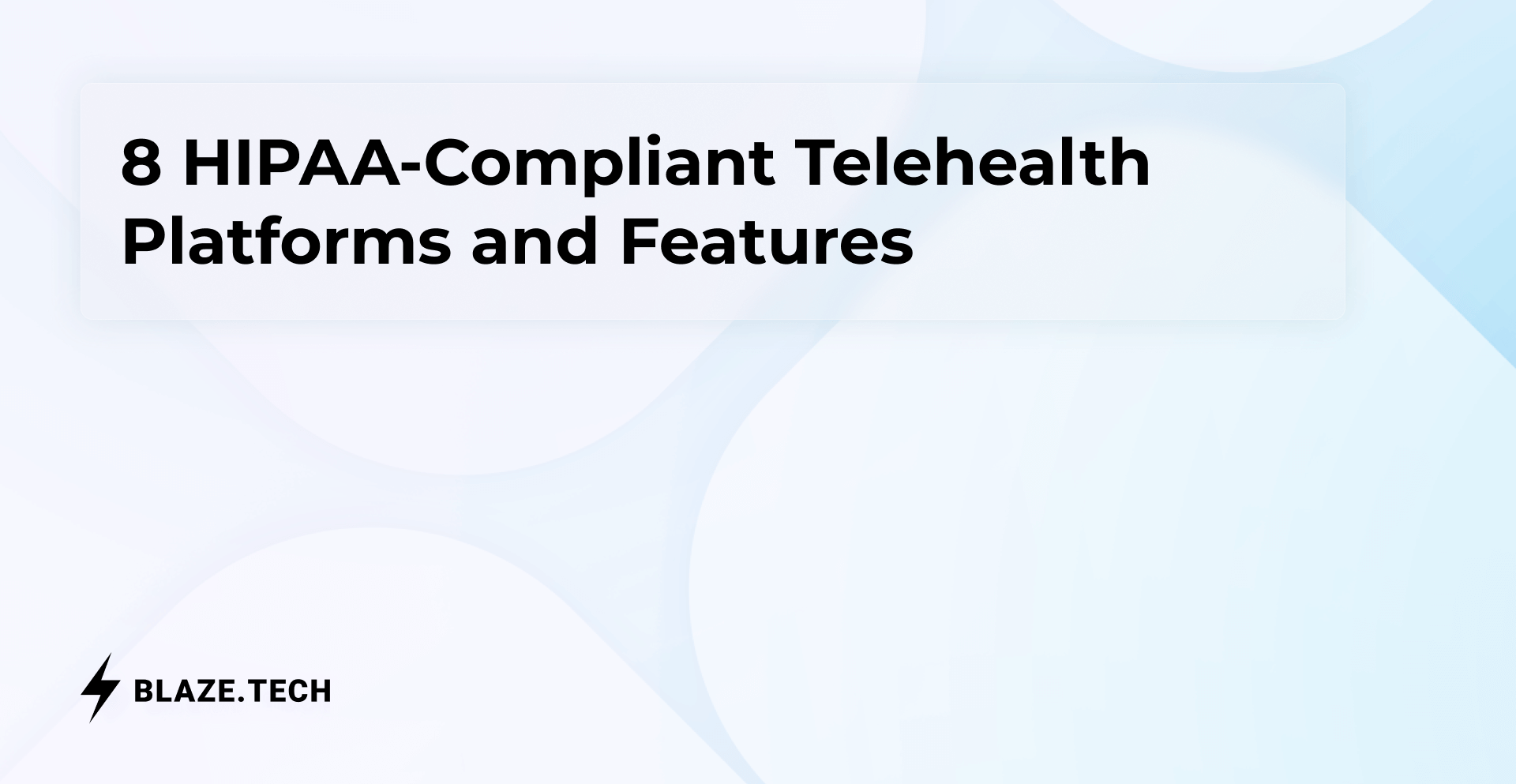
Would your telehealth platform withstand a HIPAA audit tomorrow? A HIPAA-compliant telehealth platform securely stores and transmits protected health information (PHI) in line with federal privacy laws. Our top HIPAA-compliant platforms are Blaze.tech for customization, and Zoom for Healthcare is best for small and medium clinics.
Read on to learn more about:
- The top HIPAA-compliant telehealth platforms in 2025
- What makes each tool unique for healthcare use cases, and what users are saying
- Key features to include
- Hidden costs of non-compliance
- How Blaze helps you design systems that match your workflows
Let’s take a look at the top 8 telehealth tools.
The 8 Best HIPAA-Compliant Telehealth Tools in 2025
- Blaze: Best for Custom-Built Telehealth Platforms
- Zoom for Healthcare: Best for Small and Medium Clinics
- Mend: Best for Payment + Intake Automation
- VSee: Best for Custom Medical Workflows
- Ensora Health: Best for Behavioral Health Teams
- SimplePractice: Best for Small Therapy Practices
- Qualifacts: Best for Enterprise Telehealth APIs
- Doxy.me: Best Free HIPAA-Compliant Platform
1. Blaze: Best for Custom-Built HIPAA-Compliant Telehealth Platforms

Blaze is a no-code, enterprise app builder that enables you to configure your own HIPAA-compliant telehealth platform — without code.
Who It’s For
We built Blaze to meet the needs of mid-sized to large healthcare organizations that require custom applications. When you onboard with Blaze, you won’t need to worry about hiring a traditional software development team.
Pricing
You should contact our sales team for more information about our HIPAA-compliant app builder.
Features
- Several integrations: Blaze connects easily with healthcare applications like Athenahealth, Cerner, and others. You can also connect with payment platforms like Stripe and databases like MongoDB and Microsoft SQL Server. Blaze’s REST API can also connect with lesser-known third-party applications.
- Build unlimited applications: If your clinic is scaling fast, Blaze can grow with you. Build as many applications as you like, with unlimited database storage included.
- Enterprise security features: Blaze focuses on security with SOC 2 and HIPAA compliance, as well as features such as 2FA, role-based permissions, and SSO.
Pros
- Support from day one: We guide you through every function from day one, so you’ll know how to use the platform.
- Fits several use cases: Blaze’s flexibility makes it suitable for nearly any business process requiring custom logic, forms, or data workflows. This includes everything from internal finance tools to external patient apps.
Cons
- Best suited for mid to large-sized teams: Smaller healthcare organizations might find Blaze’s enterprise-oriented toolset too complex or overpowered for startup apps or minimum viable products.
What Users Are Saying
- A Blaze user posted on G2 that the platform’s enterprise features stood out, especially when compared to other tools. The user also appreciated Blaze’s no-code simplicity, as team members could create apps whenever needed.
- A CEO of a mid-sized company praised Blaze’s helpful implementation team. He highlighted how they assisted in both building the first app and guiding his team through the platform's features. As a result, he and his team now have a solid grasp of the platform and can develop apps quickly.
2. Zoom for Healthcare: Best for Small and Medium Clinics
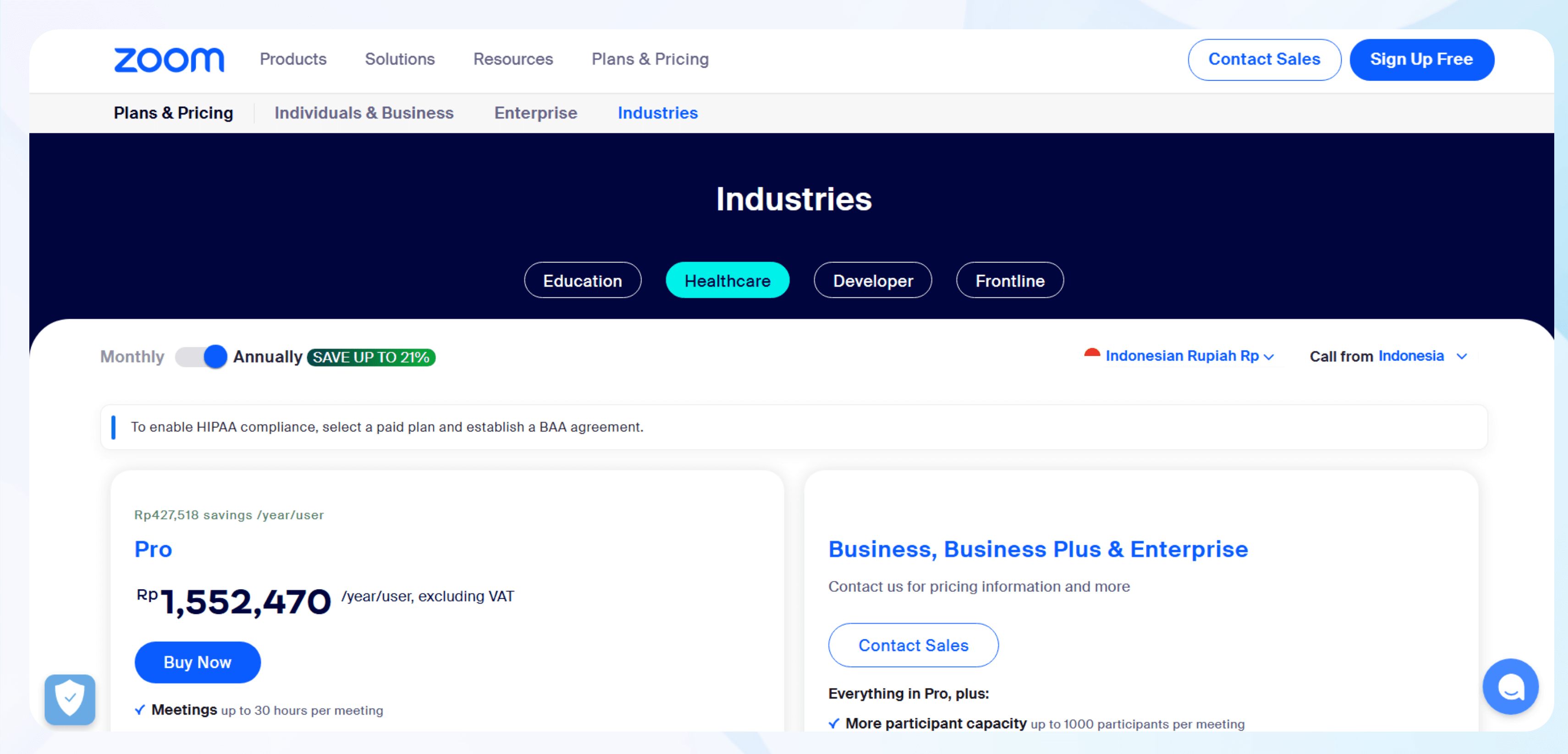
Zoom for Healthcare is a HIPAA-compliant video conferencing platform designed for healthcare providers. It supports secure virtual consultations, EHR (electronic health records) integrations, virtual waiting rooms, and end-to-end encryption.
Who It’s For
The platform meets the needs of small and mid-sized clinics that need a secure telehealth platform for video consultations. It works well for users looking to augment their existing EHR with secure telehealth capabilities.
Pricing
Zoom for Healthcare starts at $16.99/month per user and allows you to host up to 100 participants. It also supports add-ons, like Zoom Scheduler for appointment bookings for $5.99/month.
Features
- End-to-end encryption: Zoom uses AES 256-bit encryption for video, audio, and messaging. Optional waiting rooms and meeting locks give you additional access control and security.
- Supports EHR and calendar integrations: Zoom integrates with major electronic health records like Epic and Cerner for scheduling appointments.
- Handles group visits and care coordination: The platform allows multiple participants to join conferences securely, making it effective for family consults or multidisciplinary care teams working remotely.
Pros
- Cost-effective for small organizations: For small teams with fewer than 10 staff members, Zoom offers a more affordable alternative to expensive enterprise-grade telehealth platforms.
- Simple setup: Its simple interface makes onboarding with Zoom easier than many other platforms. Patients can join from a browser or app using a single link, while providers gain access to tools and administrative features in one place.
Cons
- Limited customization: Zoom focuses on secure video, not specialty medical workflows. If you need built-in SOAP notes, e-prescribing, or automated patient follow-ups, you’ll need to pair it with other tools.
What Users Are Saying
- A Zoom for Health user on Software Reviews praised the product for its ease of use, but also mentioned that the dashboard was clunky.
- Another user highlighted the platform’s video quality. But they ran into problems integrating third-party applications like clinical workflow tools and EHRs.
3. Mend: Best for Payment + Intake Automation
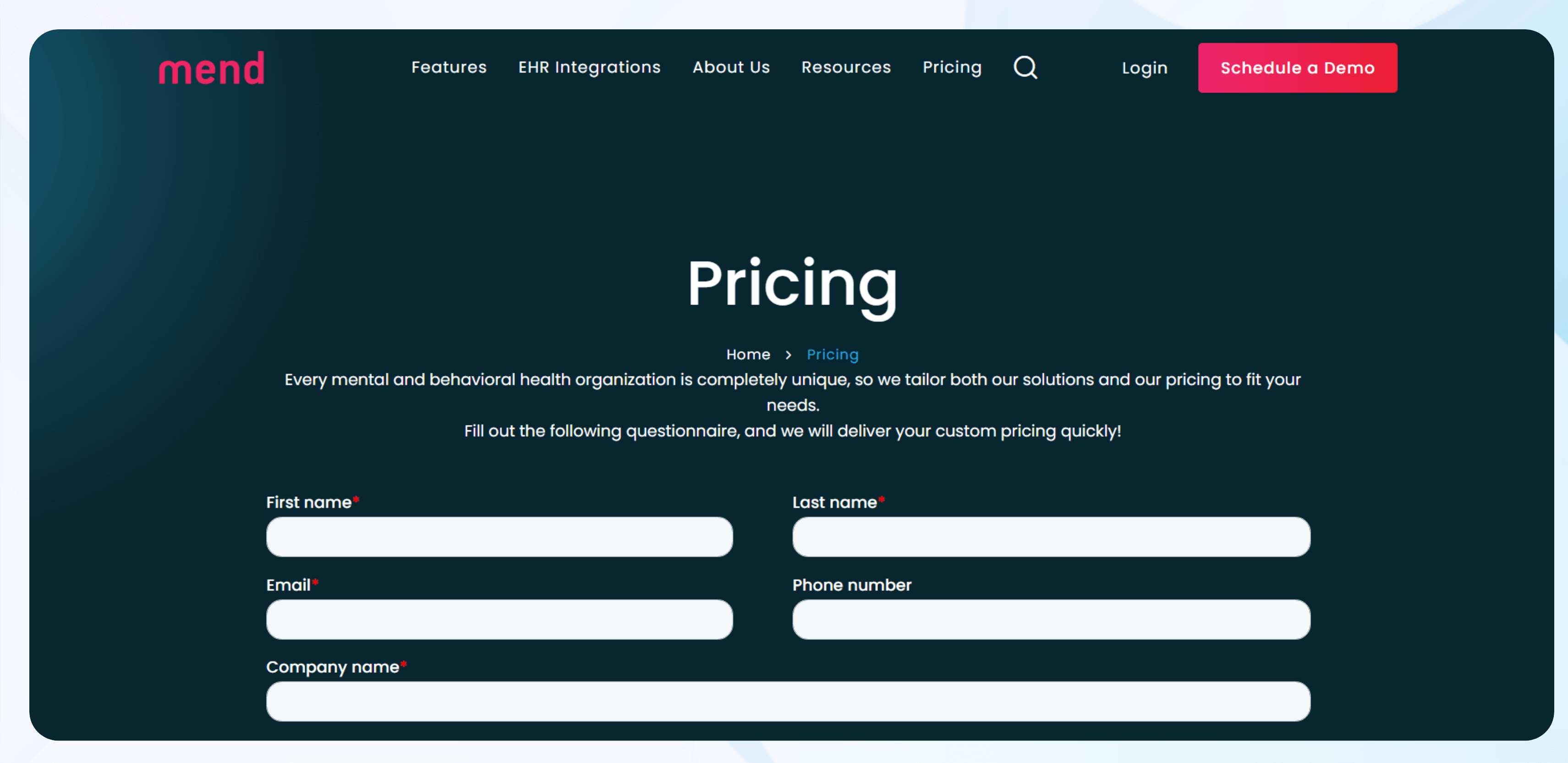
Mend is a cloud-based HIPAA-compliant telehealth platform designed for virtual care delivery. The platform delivers purpose-built telehealth tools to behavioral health professionals.
Who It’s For
Mend helps behavioral healthcare providers and counselors improve patient engagement and virtual care delivery. It supports remote therapy with features built for virtual care delivery.
Pricing
Mend doesn’t publicize its pricing information, so you’ll need to contact their team directly from the website for more details.
Features
- Secure video conferencing: Mend provides HIPAA-compliant video sessions accessible via encrypted browsers.
- Digital intake and consent forms: Patients can complete documentation directly through the platform before appointments, accelerating the check-in process.
- Automated reminders: The platform sends text and email reminders to patients as appointment dates approach to reduce no-show rates.
Pros
- User-friendly interface: Mend offers an intuitive user experience to simplify navigation for both providers and patients.
- Features and integrations: Mend offers a range of tools for video conferencing and patient intake. It also integrates with EHR platforms.
Cons
- Limited customization: It offers a set of predefined templates, which can be restrictive for users who want to create customizable workflows.
What Users Are Saying
- On Capterra, a patient using Mend praised the video and audio quality that the platform provided, which improved the sessions she had with her therapist.
- An IT professional from a healthcare clinic posted on G2 that Mend’s automated reminders help patients remember their appointments.
4. VSee: Best for Custom Medical Workflows
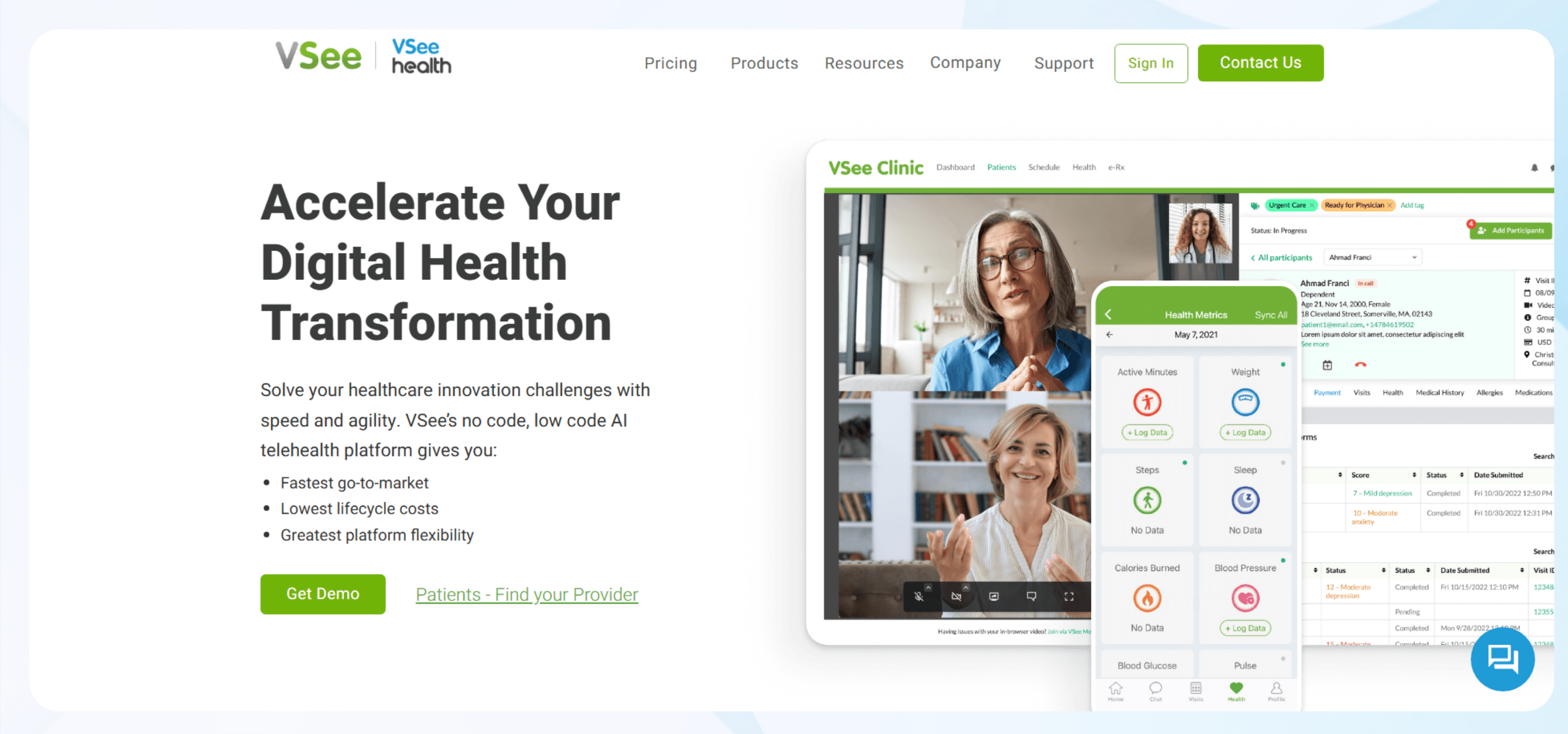
VSee is a HIPAA-compliant telehealth platform designed for healthcare providers seeking customizable virtual care solutions. Its workflows, video features, and EHR integrations make it suitable for various medical practices.
Who It’s For
VSee caters to a wide range of healthcare providers, including solo practitioners, small clinics, and large healthcare systems. Its flexibility makes VSee ideal for mental health professionals, primary care physicians, and specialists.
Pricing
Start using VSee for $29/month per provider. This plan provides a custom subdomain, video features, and a patient portal.
Features
- Customizable medical workflows: VSee offers no-code workflow customization. The platform allows you to tailor-make intake forms, triage flows, consent capture, appointment types, and follow-up actions without coding.
- Integrated remote patient monitoring and device syncing: VSee integrates with remote monitoring devices such as blood pressure cuffs, glucose meters, pulse oximeters, and wearables.
- EHR integration and API access: Larger clinics and health systems can integrate VSee with their existing EHRs and billing platforms via APIs or HL7/FHIR protocols.
Pros
- Highly customizable: VSee's platform allows wide customization, allowing healthcare providers to design workflows that align with their specific operational needs.
- User-friendly interface: The intuitive design provides easy navigation for both providers and patients.
Cons
- Add-on costs: Not all of the features are included in VSee’s standard pricing packages. For instance, you’ll need to pay an extra $49/month for the messenger feature.
What Users Are Saying
- On G2, A counselor wrote that VSee was stable and provided a reliable connection, but he had to purchase extras that he thought should be included. He didn’t state what those extra features were.
- Another clinician wrote that adjusting the audio/video settings was an easy-to-execute process, but the platform’s video feed would experience delays when a user had a slow internet connection.
5. Ensora Health: Best for Behavioral Health Teams
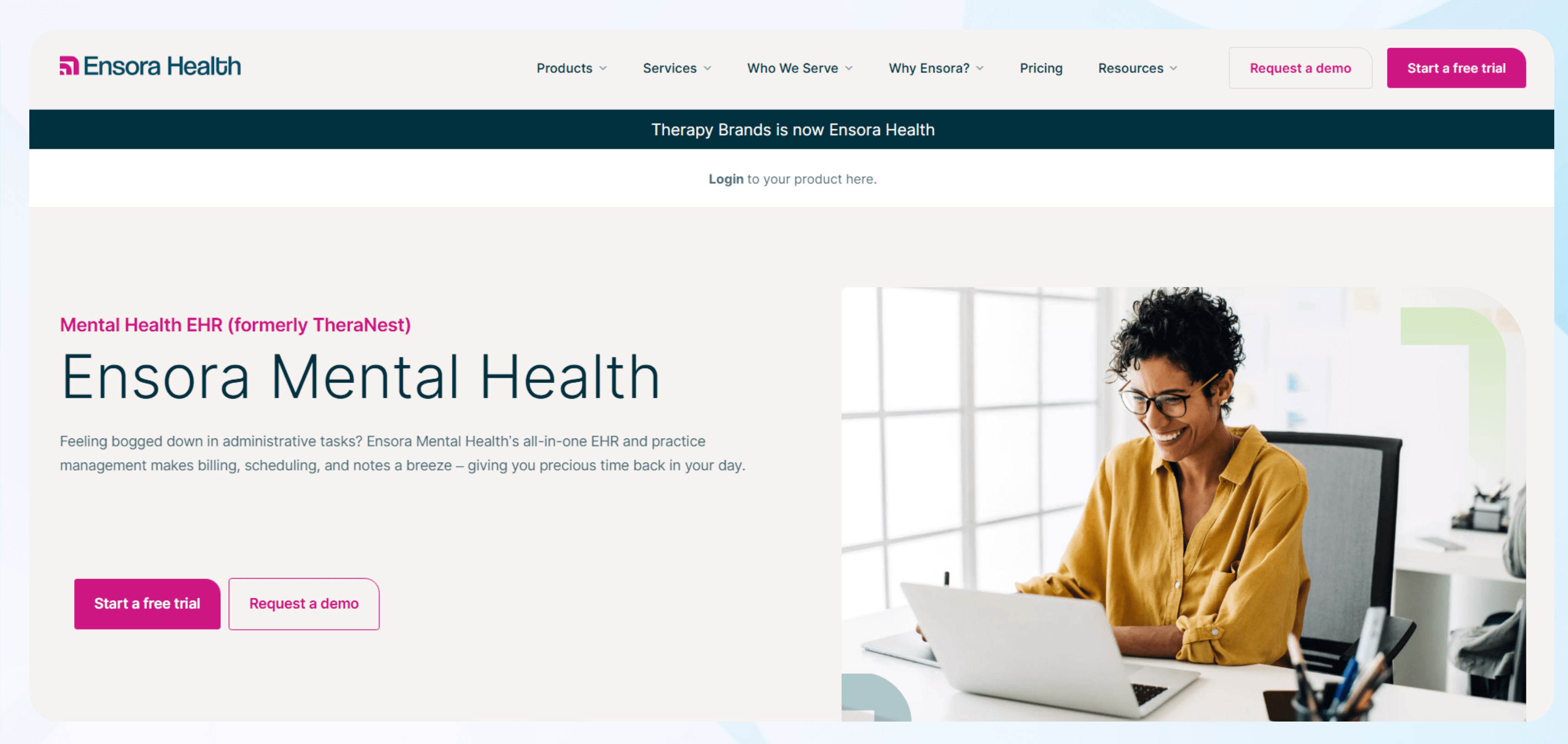
Ensora Health (formerly TheraNest) is a HIPAA-compliant EHR and practice management platform tailored for behavioral health professionals, addiction counselors, and rehabilitation programs.
Who It’s For
Ensora Health is ideal for behavioral health professionals, including therapists, counselors, psychologists, and social workers working in clinics of all sizes. It’s scalable, so it can meet the growth needs of mid-sized clinics and large group practices.
Pricing
Ensora offers 4 platforms with different pricing plans. The mental health suite starts at $29/month per user and offers a scheduling tool and client portal. It also provides a rehab therapy suite that begins at $119/month per user and offers scheduling and note-taking functions.
Features
- Various telehealth services: Ensora provides telehealth capabilities for both individual and group sessions.
- Secure Client Portal: Clients can access a dedicated portal to schedule appointments, complete intake forms, and participate in telehealth sessions.
- Scheduling tools: The platform offers intuitive scheduling with calendar sync, online booking, and automated reminders to reduce no-shows.
Pros
- Large feature set: Ensora combines important tools, including telehealth, billing, and documentation, in one system.
- Applicable to practices of all sizes: The platform’s scalable features and pricing make it ideal for professionals just starting out and large, established clinics with multiple locations.
Cons
- Complex insurance billing setup: The initial setup for insurance billing can be challenging and time-consuming.
What Users Are Saying
- A Reddit user believes that Ensora is a high-quality, feature-rich platform, but pricing has increased dramatically over the years.
- An Ensora user posted on G2 that the platform’s case-note uploading capabilities are convenient. However, the lack of integration with an AI platform makes administrative tasks cumbersome.
6. SimplePractice: Best for Small Therapy Practices

SimplePractice is a HIPAA-compliant electronic health record (EHR) and practice management platform designed for solo and small group therapy practices.
Who It’s For
SimplePractice serves therapists, counselors, psychologists, and social workers. Its design accommodates solo practitioners, small clinics, and growing group practices, but it may not have the feature set required for larger clinics.
Pricing
SimplePractice starts at $49/month and offers a 30-day free trial. It provides a client portal, contact form, and telehealth video session features. The $79/month version provides added features like appointment reminders and private messaging.
Features
- Integrated telehealth services: SimplePractice provides HIPAA-compliant telehealth capabilities for both individual and group sessions.
- Customizable documentation templates: You can tailor intake forms, progress notes, and treatment plans to fit your practice's specific documentation needs.
- Billing and claims management: SimplePractice simplifies billing processes with features like insurance claims automation, credit card processing, and batch invoicing.
Pros
- User-friendly interface: SimplePractice's user interface simplifies navigation.
- Generous feature: The platform combines tools like telehealth, billing, and documentation in one system, reducing the need for multiple software solutions.
Cons
- Not ideal for growing or large practices: SimplePractice is purpose-built for solo and small-group practices. The platform lacks enterprise-level tools like deep integrations, enterprise-grade analytics, and custom EHR workflows.
What Users Are Saying
- A clinic owner said on Capterra that the platform is easy to set up, but SimplePractice lacks customization capabilities.
- A G2 user enjoyed the fast implementation and intuitive interface, but said SimplePractice lacks scalability and offers poor customer support.
7. Qualifacts: Best for Enterprise Telehealth APIs
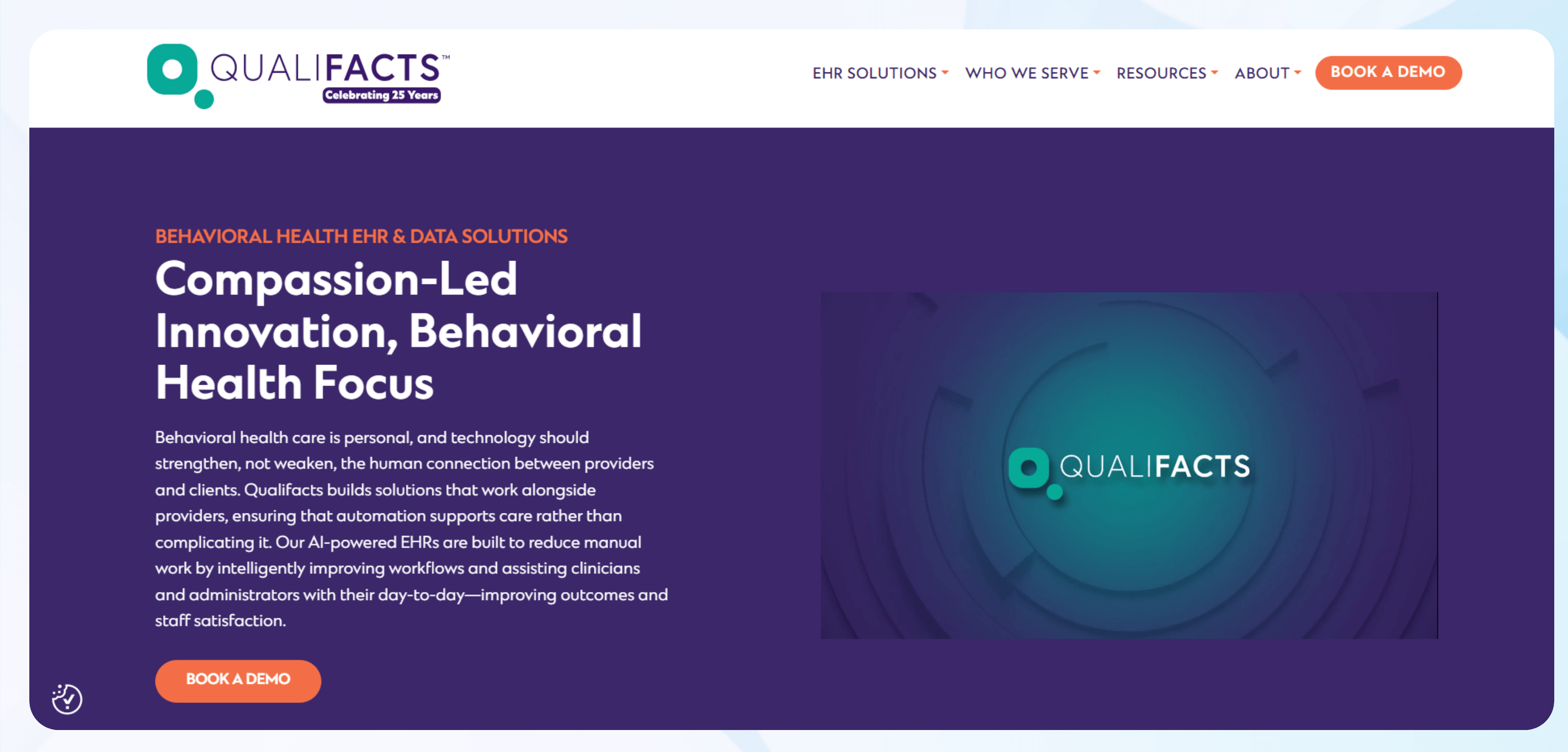
Qualifacts is a HIPAA-compliant virtual care platform designed for healthcare enterprises, behavioral health networks, and digital health startups.
Who It’s For
Qualifacts is designed to serve a broad spectrum of healthcare organizations, from small digital health startups to large enterprises. Its scalable virtual care infrastructure ensures that large healthcare systems can expand operations.
Pricing
The company doesn't publish pricing information. You should contact them for details.
Features
- API integrations: The platform offers API support, enabling integrations with electronic health records (EHRs), billing systems, and other third-party applications.
- Secure communication tools: Qualifacts provides HIPAA/PIPEDA-compliant video conferencing, secure messaging, and document sharing capabilities.
- Automated administrative functions: The platform includes features like automated appointment reminders, billing processes, and patient follow-ups.
Pros
- Scalable for many organizations: Qualifact’s customizable architecture makes it suitable for a wide range of healthcare providers, from small practices to large enterprises.
- Patient engagement: Clinicians deliver more effective care using the platform’s intuitive interface, secure messaging, and automated reminders.
Cons
- Limited group call functionality: Some users have noted that the platform's group video conferencing features fall short when compared to its one-on-one session capabilities.
What Users Are Saying
- An executive assistant at a mental health clinic posted on Capterra that Qualifacts offers excellent customer service. However, his team occasionally experiences glitches in the system.
- A billing coordinator said that the system would be better if their clinic could create their own forms, rather than using Qualifacts’ rigid ones.
8. Doxy.me: Best Free HIPAA-Compliant Platform
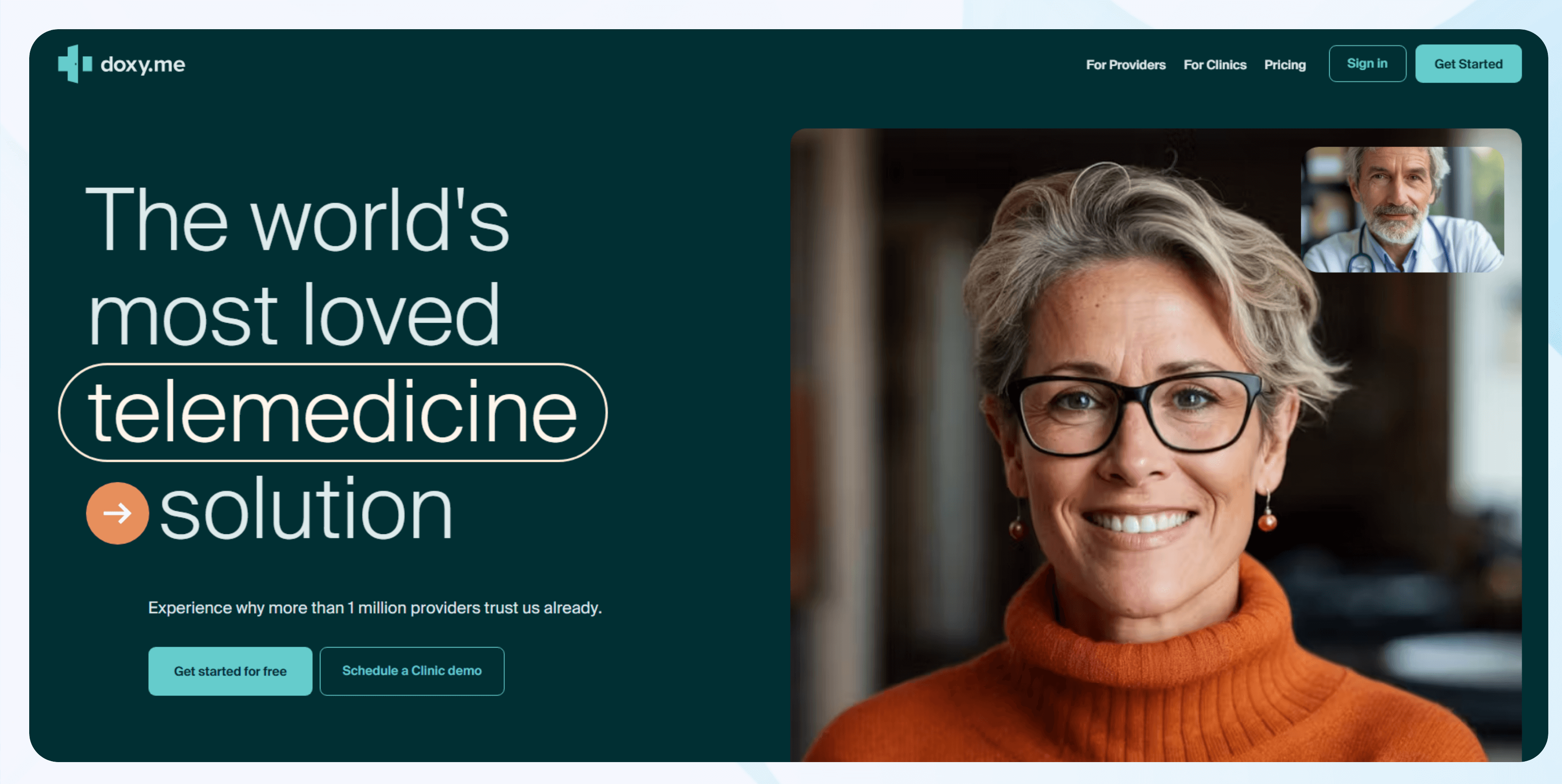
Doxy.me is a browser-based telemedicine platform designed to provide secure, HIPAA-compliant video consultations and other healthcare tasks. It’s one of the few free telehealth platforms.
Who It’s For
The platform supports a broad spectrum of healthcare providers, from solo practitioners like therapists and general physicians to nonprofit community health centers. Its free-tier access makes it attractive to organizations with limited budgets.
Pricing
Doxy’s pricing for solo practitioners costs $35/month and offers screen sharing and group calls. Larger teams choose the $50/month per-user plan to access customizable analytics dashboards and workflows.
Features
- Browser-based: Doxy operates entirely within web browsers, eliminating the need for downloads or installations.
- Virtual waiting room: Patients can check in and wait in a personalized virtual space before sessions.
- Custom branding: Paid plans allow you to customize the platform with logos and color schemes to fit your brand.
Pros
- Ease of use: The platform's intuitive design requires minimal technical knowledge, allowing for quick adoption by both providers and patients.
- Generous free version: Doxy’s free plan is one of the most generous among HIPAA-compliant telehealth platforms. It includes unlimited video sessions, a personalized virtual waiting room, and full browser-based access.
Cons
- Limited features and integrations: Compared to some competitors, Doxy lacks certain advanced functionalities like integrated billing or EHR integration.
What Users Are Saying
- On Capterra, a therapist praised Doxy’s waiting room and messaging feature, but also said the platform is slow at times.
- A therapist claims that the platform is simple to navigate, but would enjoy more customizable features.
The Best HIPAA-Compliant Telemedicine and Telehealth Platforms: TL;DR
Key Features to Look for in Secure Telehealth Tools
Secure telehealth platforms protect patient data, help execute admin tasks, and reduce legal risks. Providers must ensure HIPAA compliance by using tools that log consent forms and track every interaction. Here are the features that every telehealth platform should offer:
Video Sessions
Video sessions should feel natural for both patients and providers. To do this, HIPAA-compliant telehealth platforms need to support high-quality, low-latency video without forcing users to download extra software.
Platforms should feature screen sharing, live chat, and session timers to help keep appointments on time. Other supporting functions are appointment reminders, waiting rooms, mobile support, and simple browser access.
Consent Forms
The best platforms collect digital consent upfront and store it automatically. Your platform should allow you to attach consent forms to specific services, such as group sessions or e-prescribing.
To save time, clients should be able to sign forms remotely before the session. Maintaining a smooth process helps you stay compliant and reduces administrative headaches.
Audit Logs
Logging audits is a requirement for any HIPAA-compliant messaging app. Your telehealth platform should log every login, message, and record change. This helps resolve disputes and prove compliance during audits.
Scheduling
Smart scheduling lets clients self-book, reschedule, and receive reminders. The best HIPAA-compliant telehealth platform should manage recurring appointments, waitlists, and cancellations in one place.
External calendar syncs to platforms like Google Calendar and Outlook are helpful. But nothing beats built-in logic that blocks scheduling conflicts.
eRx
ePrescribing cuts time, phone calls, and follow-ups. A good telehealth platform should connect directly to a nationwide pharmacy network. That means you can send prescriptions securely without leaving the session.
For behavioral health and psychiatry, look for controlled substance support via eRx. You’ll want clear order histories and automatic drug interaction checks built into the flow.
The Hidden Costs of Non-Compliant Platforms
If you use a non-compliant telehealth platform, government agencies can fine you up to $1,500,000 and potentially imprison you or file criminal charges. Patients may also lose trust and turn to another provider.
Your staff will waste hours fixing problems that the platform should have handled. Insurance companies might reject your claims and even pursue legal action. The bottom line is this: If the tool can't guarantee compliance, it puts your whole practice at risk.
Should You Build or Buy Your Telehealth Platform?
Take control of workflows and patient care by building your own telehealth platform. You’ll get full control over your workflows, branding, and patient experience. Traditional telehealth platforms force you to adapt to rigid systems, limiting your ability to scale or customize workflows.
When you create your own telehealth platform, you build exactly what your clinic needs. Additionally, you can launch in weeks, not months, while remaining fully compliant with HIPAA.
Blaze Builds Telehealth Platforms Without Code
Blaze is a no-code app-building platform that enables you to create a custom, HIPAA-compliant telehealth platform — without any prior development experience. With Blaze, you build the software that fits your workflow.
Featuring a user-friendly, drag-and-drop interface and premade components, you and your team can craft a unique telehealth platform catered to execute your unique workflows. The platform can build nearly any software to support your telehealth app, like HIPAA-compliant CRMs, patient portals, video-conferencing tools, and more.
Blaze’s dedicated implementation team will set up and get your telehealth platform running smoothly. Beyond setup, they’ll show you how to build and launch new apps. We designed Blaze to grow with you so it can handle your practice as it scales.
Frequently Asked Questions
What Is a HIPAA-Compliant Telehealth Platform?
A HIPAA-compliant telehealth platform offers encrypted video calls, secure messaging, and access controls. It securely transmits and stores patient health information following the U.S. HIPAA Privacy Rule.
Tools like Blaze, Zoom for Healthcare, and VSee are examples that meet HIPAA standards, helping providers maintain legal compliance during virtual care delivery.
Do I Need a BAA for Telemedicine Tools?
Yes, you need a BAA for telemedicine tools. Any telemedicine tool handling protected health information (PHI) must sign a Business Associate Agreement (BAA) with your practice. A BAA outlines how patient data is protected when shared with third-party vendors.
Can I Build My Own HIPAA-Compliant App?
Yes, you can build your own HIPAA-compliant app. Platforms like Blaze eliminate the need for a traditional development team. Blaze is a no-code, enterprise-grade app builder designed for healthcare, offering HIPAA and SOC 2 Type II compliance out of the box.
From Scheduling to Compliance — Build It All with Blaze
Blaze is a popular tool for building HIPAA-compliant telehealth platforms thanks to its balance of features, ease of use, and scalability. It’s made to support scaling healthcare organizations, offering secure data management and customizable options that adapt to various needs.
A key advantage of Blaze is the implementation team. They’ll help you build the initial version of your app. Their support reduces the learning curve, enables you to get your app to market quickly, and allows you to learn how to develop additional apps for your healthcare clinic.
To see how Blaze can address your specific needs, we recommend trying a free demo. This will give you a firsthand look at how Blaze's features and flexibility can benefit your project.
Latest Blog & News
We love what we do and are creating a variety of resources to make you a superhero on your team! Read our articles to get inspired with what you can build with Blaze.
.png)
How to Choose the Best EHR Vendor: Features Guide (2025)

Customer Portals for Businesses

.png)